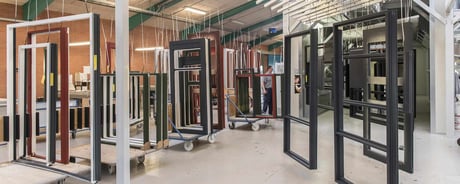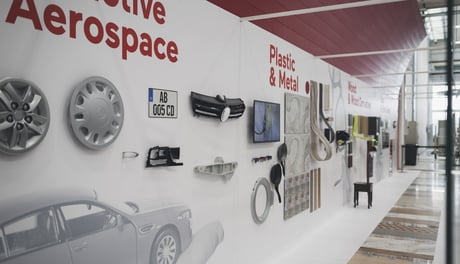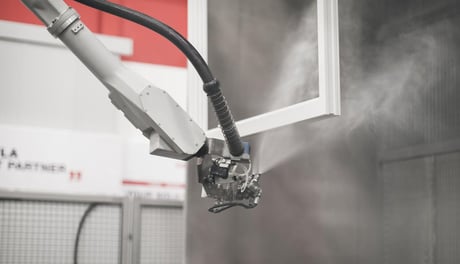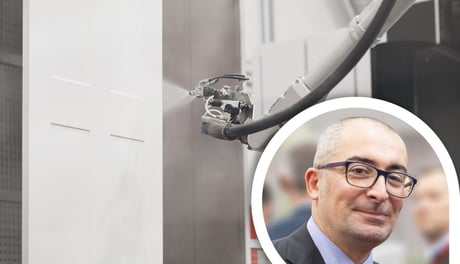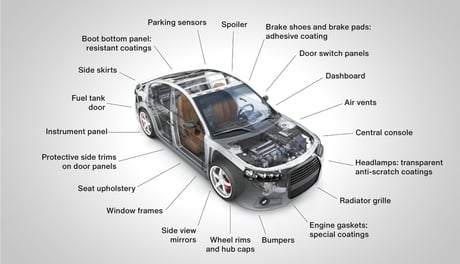
In sectors such as construction and furnishing, innovative, high-efficiency finishing processes are essential to ensure high-quality products. This article is intended for industrial window manufacturers looking for cutting-edge solutions to improve the quality and efficiency of their window production and coating processes. We’ll explore innovative techniques for finishing already-assembled windows (focusing on solutions such as overhead lines and cutting-edge Cefla Finishing technologies) and unassembled windows (analysing the potential of horizontal, vertical and hybrid lines).
What techniques are used in industrial window finishing?
In talking about window finishing, it’s vital to address the issue of tool and process customisation. Regardless of whether the windows are already assembled or whether operations are performed on individual components prior to assembly, it’s essential to have machines that can be integrated into a finishing line that meets the specific needs of the production chain. Only by adopting this approach can we boost production efficiency, providing not just economic benefits but also, above all, greater final product quality.
Industrial finishing of assembled windows
Let's start by looking at options for finishing already-assembled windows. Overhead lines offer one of the most effective solutions for treating assembled window frames. With this configuration, in fact, the chain has a closed-loop design, development of which depends on productivity and the required coating cycle. The lines are connected to each other via switching points that are automatically activated during the cycle, creating standard and/or alternative circuits.
More specifically, with regard to the Cefla Finishing range, we suggest a configuration built around two key elements: iFlow to control the impregnation phase and iGiotto to complete the finish with spray coating.
The iFlow unit is mounted on rails, without any connections to the overhead workpiece hooking line: for this reason it can easily be placed offline for cleaning and maintenance purposes. It features a sole high-capacity pneumatic pump for loading, unloading and recirculation to ensure even impregnation on the pieces.
iGiotto, instead, is a complete coating system consisting of a high-performance articulated robot, specially designed to coat large items. This is a state-of-the-art window and door frame coating system: moreover, it can be used to coat any complex shape.
Both machines can be integrated into a line that includes, for example, elevator systems, reading barriers, and drying solutions, giving rise to an extended ‘ecosystem’ that can draw on all the window finishing solutions Cefla Finishing has to offer.
Finishing unassembled windows
For not-yet-assembled frames, the process can, instead, be performed on horizontal, vertical or even hybrid lines. Depending on window finishing requirements, Cefla Finishing provides machines specifically designed to enable impregnation and drying processes that will meet the needs of any production plant.
The advantages of horizontal lines
Let's start with manufacturers who prefer to finish their windows on horizontal lines. An integrated line that handles parts horizontally offers a specific advantage: sanding is performed efficiently by the equipment and no manual intermediate sanding is required when the pieces are subsequently positioned on the vertical line for spray coating.
The horizontal line proposed by Cefla Finishing uses Lineflow and Dryflow, in addition to sealing solutions such as Talent.
Lineflow is a machine for the horizontal application of impregnating or intermediate coatings. Compared to an overhead line, horizontal execution lets the pieces remain on the line for the subsequent brushing and coating stages. The pieces can be assembled at a later time: this means the weight can be lifted with ease and only a light brushing of the profile is needed. In this process, the wood grain is better stabilized, improving subsequent spray coating stages on the overhead line.
Used in combination with LineFlow, the DryFlow oven improves the drying efficiency of water-based coatings and significantly reduces evaporation times: this is thanks to the high-speed hot air flow and product modularity, which allow for flexible selection of holding times, with short maturing/drying phases and extremely easy control.
Last but not least comes Talent. a patented vacuum-type sealing solution that uses fast-drying water-based products and is suitable for application on various types of materials.
Why choose vertical lines?
However, some manufacturers prefer to use vertical lines for unassembled frames. This is a space-efficient solution, as it lets you hang more workpieces-in-progress on the line than would be possible with pre-assembled frames.
To start the process, iFlow controls the impregnation phase using the ‘flow coating’ application system, essential for in-depth wood protection and colouring. This is followed by a drying phase in a high-airspeed oven with controlled temperature and humidity. Subsequent applications are performed by iGiotto, the articulated robot that uses pre-set spraying trajectories, either programmed or automatically established by a 2D or 3D reading barrier. The iGiotto consistently applies the desired coating quantity; this is then dried in a high-airspeed oven with controlled temperature and humidity. Manual sanding usually precedes application of the transparent water-based finish.
Cefla Finishing and window finishing solutions
Modularity, flexibility, efficiency and high performance are the hallmarks of a range designed to meet every window coating requirement. What’s more, years of experience gained all over the world have allowed us to respond to extremely diverse, highly specific needs: just think of the different climates in the countries where Cefla Finishing operates, and the level of knowledge needed to treat the huge variety of woods with which windows are made on different markets.
Hence our mission: to customise our machines down to the last parameter so we can meet the specific needs of every single company. Come and test your products and coatings on our machines at the world’s largest finishing lab, here in Imola, Italy. This will help us define the ideal characteristics of the lines to be developed and installed, ensuring perfect processing: just what your business needs.

